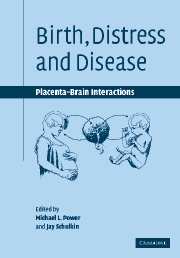Book contents
- Frontmatter
- Contents
- List of contributors
- Preface
- Introduction: brain and placenta, birth and behavior, health and disease
- 1 Placental expression of neurohormones and other neuroactive molecules in human pregnancy
- 2 The regulation of human parturition
- 3 Maternal nutrition and metabolic control of pregnancy
- 4 Fetal HPA activation, preterm birth and postnatal programming
- 5 Prenatal glucocorticoids and the programming of adult disease
- 6 Prenatal stress and stress physiology influences human fetal and infant development
- 7 Glucocorticoids and the ups and downs of neuropeptide gene expression
- 8 Glucocorticoid facilitation of corticotropin-releasing hormone in the placenta and the brain: functional impact on birth and behavior
- Index
1 - Placental expression of neurohormones and other neuroactive molecules in human pregnancy
Published online by Cambridge University Press: 16 October 2009
- Frontmatter
- Contents
- List of contributors
- Preface
- Introduction: brain and placenta, birth and behavior, health and disease
- 1 Placental expression of neurohormones and other neuroactive molecules in human pregnancy
- 2 The regulation of human parturition
- 3 Maternal nutrition and metabolic control of pregnancy
- 4 Fetal HPA activation, preterm birth and postnatal programming
- 5 Prenatal glucocorticoids and the programming of adult disease
- 6 Prenatal stress and stress physiology influences human fetal and infant development
- 7 Glucocorticoids and the ups and downs of neuropeptide gene expression
- 8 Glucocorticoid facilitation of corticotropin-releasing hormone in the placenta and the brain: functional impact on birth and behavior
- Index
Summary
Introduction
The human placenta and its accessory membranes (amnion and chorion) actually undertake the role of intermediary barriers and source(s) of active messengers in the maternal—fetal dialog. In the past decades, an accelerated progress in the understanding of physiological roles and of pathological influences of the placenta and other gestational intrauterine tissues (fetal membranes and deciduae) has occurred. These organs and tissues produce brain, pituitary, gonadal and adrenocortical hormones (Petraglia et al., 1990b; 1996d; Petraglia, 1991; Reis et al., 2001; 2002), chemically identical and as biologically active as their hypothalamic/gonadal counterparts and, when added to placental cell cultures, they modulate the release of both pituitary-like peptide hormones and gonadal/adrenal cortex-like steroid hormones. Thus, the intraplacental mechanism of control of hormone secretion resembles in many aspects the organization of hypothalamus—pituitary—target organ axes. Under this perspective, the human placenta may be considered as a neuroendocrine organ, since its secretion of substances analogous to neurohormones, neuropeptides, neurosteroids and monoamines (Table 1.1) have endocrine, paracrine and autocrine function (Petraglia et al., 1996d).
Physiological functions of these placental secretions include:
to maintain an equilibrium between the fetus and the mother;
to provide a favorable uterine environment at implantation;
to regulate fetal growth during pregnancy;
to direct the appropriate signals for the timing of parturition.
- Type
- Chapter
- Information
- Birth, Distress and DiseasePlacental-Brain Interactions, pp. 16 - 73Publisher: Cambridge University PressPrint publication year: 2005
- 5
- Cited by



